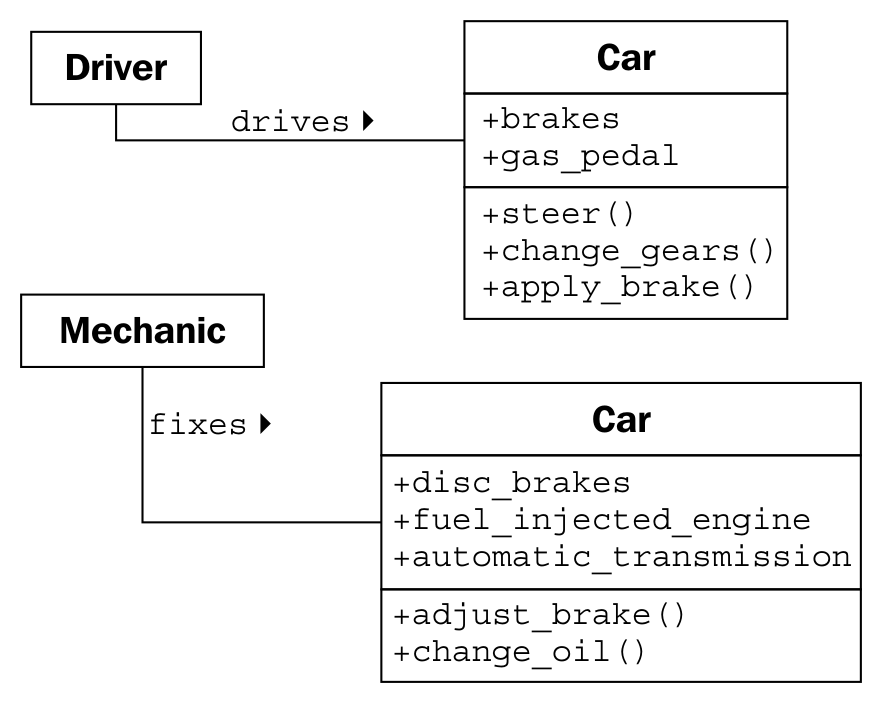The key purpose of modeling an object in object-oriented design is to determine what the public interface of that object will be. The interface is the collection of attributes and methods that other objects can access to interact with that object. They do not need, and are often not allowed, to access the internal workings of the object.
A common real-world example is the television. Our interface to the television is the remote control. Each button on the remote control represents a method that can be called on the television object. When we, as the calling object, access these methods, we do not know or care if the television is getting its signal from a cable connection, a satellite dish, or an internet-enabled device. We don't care what electronic signals are being sent to adjust the volume, or whether the sound is destined for speakers or headphones. If we open the television to access the internal workings, for example, to split the output signal to both external speakers and a set of headphones, we will void the warranty.
This process of hiding the implementation of an object is suitably called information hiding. It is also sometimes referred to as encapsulation, but encapsulation is actually a more all-encompassing term. Encapsulated data is not necessarily hidden. Encapsulation is, literally, creating a capsule (think of creating a time capsule). If you put a bunch of information into a time capsule, and lock and bury it, it is both encapsulated and the information is hidden. On the other hand, if the time capsule, has not been buried and is unlocked or made of clear plastic, the items inside it are still encapsulated, but there is no information hiding.
The distinction between encapsulation and information hiding is largely irrelevant, especially at the design level. Many practical references use these terms interchangeably. As Python programmers, we don't actually have or need true information hiding (we'll discuss the reasons for this in Chapter 2, Objects in Python), so the more encompassing definition for encapsulation is suitable.
The public interface, however, is very important. It needs to be carefully designed as it is difficult to change it in the future. Changing the interface will break any client objects that are accessing it. We can change the internals all we like, for example, to make it more efficient, or to access data over the network as well as locally, and the client objects will still be able to talk to it, unmodified, using the public interface. On the other hand, if we alter the interface by changing publicly accessed attribute names or the order or types of arguments that a method can accept, all client classes will also have to be modified. When designing public interfaces, keep it simple. Always design the interface of an object based on how easy it is to use, not how hard it is to code (this advice applies to user interfaces as well).
Remember, program objects may represent real objects, but that does not make them real objects. They are models. One of the greatest gifts of modeling is the ability to ignore irrelevant details. The model car I built as a child looked like a real 1956 Thunderbird on the outside, but it obviously doesn't run. When I was too young to drive, these details were overly complex and irrelevant. The model is an abstraction of a real concept.
Abstraction is another object-oriented term related to encapsulation and information hiding. Abstraction means dealing with the level of detail that is most appropriate to a given task. It is the process of extracting a public interface from the inner details. A car's driver needs to interact with the steering, accelerator, and brakes. The workings of the motor, drive train, and brake subsystem don't matter to the driver. A mechanic, on the other hand, works at a different level of abstraction, tuning the engine and bleeding the brakes. Here's an example of two abstraction levels for a car:

Now, we have several new terms that refer to similar concepts. Let's summarize all this jargon in a couple of sentences: abstraction is the process of encapsulating information with separate public and private interfaces. The private interfaces can be subject to information hiding.
The important lesson to take from all these definitions is to make our models understandable to other objects that have to interact with them. This means paying careful attention to small details. Ensure methods and properties have sensible names. When analyzing a system, objects typically represent nouns in the original problem, while methods are normally verbs. Attributes may show up as adjectives or more nouns. Name your classes, attributes, and methods accordingly.
When designing the interface, imagine you are the object and that you have a very strong preference for privacy. Don't let other objects have access to data about you unless you feel it is in your best interest for them to have it. Don't give them an interface to force you to perform a specific task unless you are certain you want them to be able to do that to you.


